Download this Backgrounder as a pdf
Read the panel discussion transcript
- The President’s guest-worker proposal for illegal immigrants has had no discernable impact on Latino voters. Candidate positions on immigration policy are a low priority for Latino voters.
- Latino voters have remained remarkably stable in their political views, preferring Democrats over Republicans by a margin of two to one nationally and in most states.
- The vast majority of Latino voters live in states that are not battlegrounds in the current presidential race, thus their impact on the current election will be more modest than previously thought.
In 2001, joined by a coauthor, I examined the contours of Latino political attitudes based on several reliable surveys and found that there was not much hope of significant Latino realignment from the Democratic to the Republican party anytime soon (Gimpel and Kaufmann 2001). This research indicated that Latinos attracted to the GOP were not attracted to that party on the basis of positions it was taking on immigration politics and policy. Our point at the time was to suggest that it was fanciful for White House operatives to expect Latinos to move even modestly toward the Republicans on the basis of a temporary guest-worker program, an “amnesty,” or whatever the proposed legislation came to be called. Such a program might please business constituencies reliant on low-cost immigrant labor, including some big GOP contributors, but it was a blunt and clumsy instrument for the political conversion of Latinos.
In early 2003, I followed up the earlier report with a brief look at the Fox News Exit Polls on the 2002 election. These polls indicated that the Republicans had made no appreciable gains among Latinos (Gimpel 2003). To the extent that the proportion of Latinos voting Republican had increased, it was principally a consequence of their low turnout in heavily Democratic areas coupled with the lopsidedness of some of that year’s gubernatorial elections. Voters, regardless of ethnicity, are far less likely to turn out to vote when they know that the outcome is decided well in advance.
In spite of erroneous press reports that the Latino electorate had moved between 2000 and 2002, and the willingness of naïve Democrats to believe it, the evidence available for public scrutiny, including national and state level exit polls, simply does not show that there was appreciable movement toward the GOP. Many may have mistaken low turnout among Democrats for concrete Republican gains, but the two are not even close to being the same. The moral of the mid-term story was clear: Republicans do better when Latinos stay home.
There is little question that the Republicans have put together an impressive re-election effort for 2004. While last minute surprises have been known to happen, as of this printing President Bush appears to be destined for a second term. But a Republican victory will probably not hinge upon Latino outreach or administration immigration policy as much as on the politics of the war on terrorism, the gradual return of prosperity, and an impressive ground game put in play by Republicans.
In this study, I examine still more evidence for the durability of fundamental political predispositions, repeating the case that elections are mostly about turnout, not persuasion. The data presented provide support for the contention that partisanship is very durable. Members of Congress and the executive branch cannot simply change substantive opinions on a whim, despite what consultants might try to sell them. Hispanic partisans are no different from any other citizens who have acquired a party identity. Once partisanship is formed, usually by early adulthood, it is highly durable over the course of the life-cycle (Green, Palmquist, and Schickler 2002). It takes quite unusual circumstances to jar someone loose from such deeply seated moorings.
Persuasion usually fails because citizens, whether they vote or abstain, are not sufficiently attentive to politics and events to closely follow who is offering up what policy program. Voters develop vague impressions of candidates and parties, but rarely are they able to articulate in detail what they stand for (Dalager 1996). Thankfully, there are many matters occupying the lives of our citizenry that are more important than politics: family, church, work, and school.
One of the fundamental ironies of American political behavior, pointed out many years ago by Philip Converse ((1962; 1964; Zaller 1992), is that the most attentive segment of the population is least likely to be moved because of their deeply entrenched political commitments. The inattentive, on the other hand, are also immovable but this is because they are not collecting enough information to be persuaded. Presumably that leaves a middling range of voters who are movable, but one has to ask who they are and where they live. Persuadable voters wind up being rather inconsequential if they reside in states that are not significant battlegrounds. With the number of battleground areas in ever shorter supply, persuasion-oriented appeals should be reserved for a rather small and shrinking subset of the total electorate. This year, as in prior years, Latinos may not be members of the relevant subset—or not many of them anyway.
Looking Back at 2002
One bit of popular wisdom emerging from the 2002 elections was that Republicans had done spectacularly well in the mid-terms due to GOP outreach efforts to non-traditional constituencies, including Hispanics. When the 2002 VNS exit polls finally became available for analysis, they allowed a direct test of this assertion, beyond the evaluation reported in the previous CIS Backgrounder that relied on the exit polls from Fox News (Gimpel 2003).1
In the U.S. Senate races, the national VNS exit poll indicated that 32 percent of Latinos voted Republican and 65 percent voted Democratic (see Table 1). For governor, 33 percent of Latinos voted Republican, and 61 percent Democratic—hardly an impressive showing given that a number of these elections were non-competitive mismatches. And given the far lower turnout that characterizes mid-term elections, these figures suggest the high probability that the GOP may have even lost ground in 2002 among Latinos.

Knowing that the mid-term drop-off in turnout is most likely to occur among less educated and lower income voters, and those in large central cities, we had every reason to expect a substantial jump in Republican support among those who did show up. But the increase in Hispanic support was negligible in spite of the low turnout among core Democrats in big cities. For instance, private campaign polls revealed that Rick Perry’s landslide defeat of Tony Sanchez was anchored not in Hispanic support, but in massive turnout by whites in suburban Texas (Yardley and Canedy 2002). GOP turnout efforts mattered a lot in that contest, but GOP outreach to non-traditional constituencies did not.
That the 2002 election would not result in significant gains for the GOP among Hispanics was entirely foreseeable through survey research done by ABC News and The Washington Post in late-September, October and November of that year.2 These polls indicated that 71 percent of Latinos surveyed were fully intending to vote for Democratic House candidates, while 29 percent favored Republicans. Republicans fared only marginally better among Latinos who were registered voters in those surveys. These same polls indicate that the President’s approval rating among Latinos did not improve significantly during the late weeks of the fall 2002 campaign, although it did among non-Hispanic whites.
Previous research has shown that Latino political participation ebbs and flows contingent on contacting and mobilization efforts by parties and politically oriented groups (Shaw, de la Garza, and Lee 2000; Johnson, Stein, and Wrinkle 2003). Like other Americans, only a fraction of the Latinos who turned out in 2000 returned to vote in 2002, and those who did were more likely to be GOP partisans, and to live in smaller cities and towns rather than large cities (shown in Figure 1). The differences in the size of the Hispanic electorate by place of residence shown in Figure 1 are especially telling. These figures provide convincing evidence that it was the most Democratically inclined Latinos, including many of those in the nation’s largest (and most Democratic) cities, who remained at home in 2002.
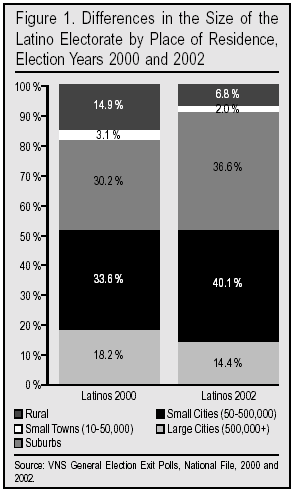
In addition, Table 2 shows that 73 percent of the Latinos voting in big cities were Democrats in 2000, but in 2002, that proportion dropped to 68 percent. In 2000, only 9 percent of the Latinos turning out in large central cities were Republican, but in 2002, this doubled to 18 percent. These changes are not the result of persuasive outreach, but the result of a badly shrunken Democratic electorate, particularly in the largest cities whose overall electoral contribution dropped from 18 to 14 percent, while the electoral contribution of suburbs and smaller cities surged (see Figure 1). Notably, turnout among rural and small town Latino Democrats also dropped significantly from 2000 to 2002. What does all this add up to? The impressive GOP successes in the 2002 election were almost entirely a result of the president’s positive image among traditional constituencies—and the enthusiastic mobilization of those constituencies—while Democratic turnout lagged.
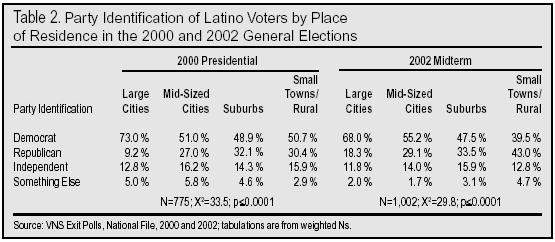
That November 2002 did not mark the dawning of a new political day is further amplified by looking at the 2002 VNS exit poll question about whether Hispanic respondents would support President Bush or an unknown Democrat in the coming 2004 election. These results are reported in Table 3, and show that in spite of the low turnout among Democratically inclined Latinos in the 2002 elections, just 38.5 percent of Hispanics who did vote reported that they would support President Bush in 2004, 32 percent for the unknown Democrat, and 28 percent were undecided.
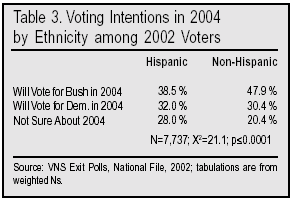
A large bloc of undecided voters would appear to be good news for the Republicans except that a solid majority of undecideds were Gore supporters in 2000 and Democratic identifiers who would likely find their way back in that direction in the next two years. One year later, in October 2003, an ABC News/Washington Post poll of likely voters indicated that Hispanic support for the still unknown Democratic nominee was 59 percent. The President’s support among Hispanics stood at 26 percent, with the remaining undecided. Even if the Republicans wound up splitting this undecided vote evenly with the Democrats—a very unlikely outcome given that undecided populations typically break toward their majority—the GOP would still be at just 33 percent. It is possible that President Bush could do better than this, but aside from low turnout, it would typically require a lopsided election margin to see this happen. The Kerry-Edwards campaign would have to unravel to an even greater extent than it has already—certainly a possibility based on what we have observed of the Democratic team so far.
Party affiliation figures over time also indicate that so far the GOP outreach strategy has not been highly successful on the persuasion front. Recently published results from the Pew Hispanic Center/Kaiser Family Foundation 2004 National Survey of Latinos state that the Democrats’ two-to-one registration advantage over Republicans among Hispanics has remained unchanged since 2000. Democrats are overwhelmingly seen as the party that has the most concern for the interests of Latinos, although very high proportions of unregistered Latinos and non-citizens do not believe that either party cares.
Perhaps even more surprising is the fascinating Pew finding, reproduced here from their own report, that immigration reform ranks 11th in importance to registered Latino voters, behind education, the economy, and jobs, and a host of other issues (see Figure 2). Of course it’s not clear that issues aside from the top two or three on this list matter at all to how people vote once we take into account their basic party attachments. Rather than immigration issues, the results in Figure 2 suggest that Democratic and Republican campaigns might be marginally better-off discussing the federal budget deficit or taxes with audiences of Hispanic voters, and would be much better-off discussing education and the economy. Undoubtedly it will astonish some political operatives within both Democratic and Republican camps to learn that Latino voters care about the very same things that all other Americans care about. And if President Bush improves his standing among Latinos in a second term, it probably will not be because he did anything to open the doors wider to illegal immigrants. If there are any issues that could be used to convert the Latino population, immigration does not seem to number prominently among them.
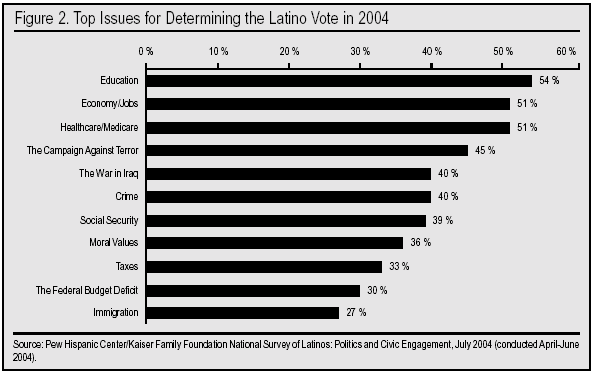
Presidential Approval after 9/11
The September 11th tragedies have been a touchstone of President Bush’s first term in office. If the President is reelected, it will be due in large part to favorable impressions generated by his leadership and decisiveness during a critical time in the nation’s history. The question for present purposes is whether Latinos have moved toward or away from the President in the weeks and months since 9/11, when compared with other citizens.
Answering this question required the pooling of all of the ABC News/Washington Post monthly polls taken after 9/11 and continuing through May 2004—the most recent month for which these data are publicly available. This effort involved the examination of 32 separate surveys and some 33,000 individual responses to questions about the president’s job approval, his economic job performance, and related questions across 140 weeks from the third quarter of 2001 to May 2004. A graph of these job approval trends is shown in Figure 3, for all respondents to these surveys, and specifically for Latino respondents.
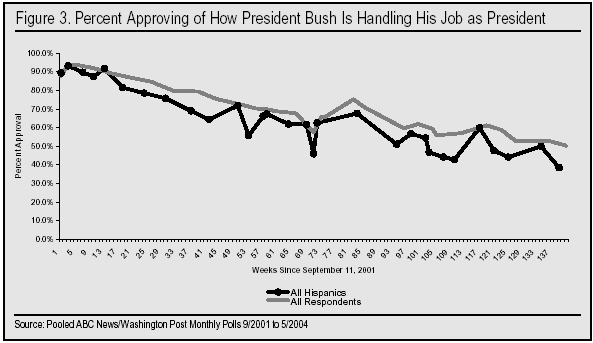
First, we should note that approval has dropped among all respondents to these polls by an average of 0.8 points per week, in simple linear terms, over the period covered by the study. This amounts to about 3.2 points per month decline from the peak approval immediately after the 9/11 crisis. Among Hispanic respondents, however, the decline has been at least as steep if not steeper. Calculations across the collection of individual respondents from each poll indicate a weekly drop in approval of about 0.9 points, or 3.4 points monthly since 9/11.3
Consistent with the power of traditional party cues, the decline has been greatest among Latino Democrats, while Latino Republicans have maintained a highly favorable view of the president’s overall job performance. Notably, the few Latino independents identified by these ABC News/Washington Post surveys show no appreciable movement toward the President over the course of the post-9/11 period. Certainly it could be worse: At least these independents are not as negative about the President as the Latino Democrats, but it doesn’t appear from this evidence that they have been won over to the GOP side in any consequential numbers. The figures suggest a basic continuity with past trends, including those that prevailed when the President’s father occupied the White House.
What about the President’s performance with the economy? Figure 2 showed that Hispanics joined most other Americans in stating a concern about the economy and jobs as their second most important issue behind education. When evaluating the President’s economic approval numbers, it should first be noted that President Bush did not start the series with the high marks that he did on overall job approval. The practical import of this difference is that his economic approval rating has not had as far to fall and the month-to-month decline has not been as steep. Over time, the decline in the President’s economic approval rating has dropped among all respondents by about 0.76 points per month in simple linear terms (see Figure 4). Among Latino respondents, economic approval has dropped by a significantly greater 1.04 points per month. Among Latino independents, we see no significant movement toward the President through May 2004, although the small number of Latino independents renders any statistical estimate an informed guess.
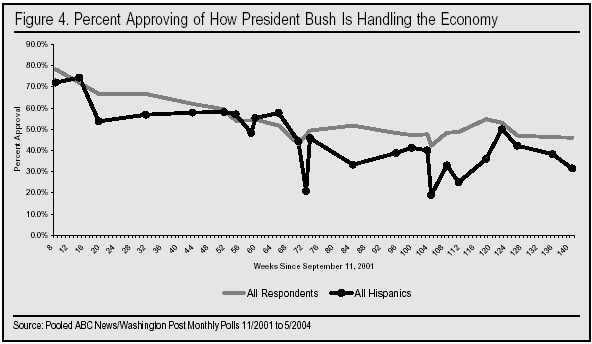
To be sure, the President’s job approval remains high, buoyed by consistently high marks in his management of the war on terror. His performance in this specific policy arena may be high enough to secure his reelection, particularly if his campaign continues to emphasize this theme. Notably, the President’s performance in combating the war on terror receives strong approval among Latinos. This only bolsters the finding from the Pew Hispanic Center’s study that the war on terror is among the four most important themes that will guide the judgments of Latinos in November. It also suggests that Latinos are not distinct from other American voters in how they evaluate the candidates’ issue positions, and that GOP progress among Hispanics will be based on mainstream, run-of-the-mill appeals, as opposed to narrowly tailored policy proposals benefiting only a few.
Do the President’s Immigration Proposals Help with Women Voters?
We have seen that the President’s approval rating among Hispanics has moved downward after 9/11 at a pace consistent with or exceeding general trends in public opinion. This downward movement was not halted by the January 2004 announcement of a major policy initiative on guestworkers. But one intriguing argument that has been voiced inside the Beltway is that the President is reaching women, liberals, and potential crossover voters by assuming a more generous posture toward illegal immigrants. According to this line of reasoning, the aim is not to attract Latino voters per se, but to attract crossovers who might value diversity and be sympathetic to the plight of hard-working illegal immigrants. The strategic calculation is that inclusiveness will pay political dividends well beyond the group targeted for the actual policy benefits. Cynical conservative commentators have dubbed this idea the “ricochet pander.” It is certainly a clever argument, but is it true?
The January 2004 ABC News/Washington Post poll, taken coincident with the Bush Administration’s announcement of its major immigration policy initiative, casts considerable doubt on the notion that women are moved in the President’s direction by his stand on immigration. A simple tabulation of approval of the president’s performance on immigration by gender appears in Table 4. These results show that not only did a solid majority of respondents disapprove of the President’s performance on immigration at that time; there is no statistically significant difference in the views of male or female respondents. A further examination of the items on this ABC/WP January survey reveals that whatever modest gender gap there is in immigration attitudes, the women who approved of the President’s January policy initiative were inclined to like him anyway. They were not crossover supporters who had been persuaded. Since the President’s position on immigration will always be seen as less generous than the Democrats’, it is difficult to see how those among the tiny number of politically uncommitted citizens who look to a policy of high immigration as a voting cue could move in the President’s direction. To be sure, other evidence needs to be brought to bear on this question—one snapshot of public opinion does not constitute proof. But our prima facie examination indicates that gender differences in support for the President will not be erased by his present immigration policy initiatives.

Latinos in Battleground and Non-Battleground States
The chances that Latinos will be a swing constituency in the November election are looking slim. First, only one out of four Latino voters lives in a purple state—a state considered by strategists to be competitive in this presidential election. Nearly 60 percent of all Latinos live in California, Texas, and New York—locations that are not considered battlegrounds. The silver lining for the Bush-Cheney campaign is that these hopeless states are home to the most Democratic-leaning Hispanics who have become politically marginalized by their very concentration. The Latino population in the battleground states is somewhat less Democratic, and very possibly warmer to the President’s reelection.
Taking stock of the current political terrain, it would appear that the Latino vote could make a difference in Arizona, Nevada, New Mexico, Colorado, and Florida.4 But what do the Latinos living in these states want? Given the narrow geographic distribution of the Latino voters who really matter, questions do arise about whether campaign messages and policy promises have been framed around the correct subset of a subset of a population that has proven so difficult to move. This is not a trivial point given that the Latino community is substantially divided on many issues, including immigration, same-sex marriage and abortion rights—the latter two of which are widely thought to evoke consensus among culturally conservative social groups.5 Perhaps Latinos are not so culturally conservative after all. Maybe they are not even properly considered a bloc (Gimpel 2003).
In the shadow of the 2000 election, and particularly the Florida debacle, every vote counts, so let us imagine that the Latinos in these four states could really decide the outcome. In order to best his 2000 performance, the president needs to win more than 34.5 percent of the Latino vote in Arizona, more than 32.4 percent in New Mexico, 49.5 percent in Florida, and more than 33 percent in Nevada. A decisive across-the-board win in November could help him to reach these goals. Our research does show that the president’s job approval rating has remained consistently highest among Latinos residing in the Mountain states. The Bush-Cheney campaign’s surest path to improved performance among Latinos in these states is through the mobilization of more Hispanic Republicans.
Another possible scenario is that many Latinos simply stay home in 2004 so that it appears that the President has converted Latino voters when it was really the Democrats who failed to mobilize core constituencies. This was the pattern observable in the 1998 Texas gubernatorial election, when George W. Bush came by the apparent misimpression that he had made inroads into the Latino community there when, in fact, legions of Latino Democrats were deactivated by an especially weak Democratic candidate. This was also the story of the 2002 mid-terms, which I have addressed above and elsewhere.
In the end, though, any GOP uptick in these states—whether stimulated by higher turnout of GOP-inclined Latinos, the deactivation of Democrats, or the movement of independents—will have nothing to do with position-taking on immigration policy to which the Latino population is largely oblivious. If President Bush improves upon his earlier performance and turnout levels are substantially the same (or better), it will be the result of economic times looking brighter, because of his leadership in the war on terrorism, and because of an inept Democratic effort. In this scenario, we would expect the President to gain ground across the board, even among other hardened Democratic constituents such as union members and African Americans. The upshot is that if we see Latino movement toward the GOP, it will be movement that is also visible among other social groups typically biased in favor of Democrats. Latinos, alone, could move toward the GOP, while other traditional Democratic constituencies remain behind, but this possibility is remote based on the regularities in political behavior we have been observing.
Conclusions
Some strategists might insist that a win resulting from low turnout among opposition forces is just as good as a win that results from the persuasion of once hostile or fence-sitting voters. But others would respond that the distinction is vast. A victory based on persuasion usually presumes that voters have come aboard as a result of a candidate’s issue positions or policy views, and that the victory entails a political mandate to enact those policies. A victory resulting from the disinterest and deactivation of the opposition implies no such mandate. A win is not just a win. The contours of one’s electorate represent a governing coalition that guides subsequent policy decisions. What politicians come to believe about their own elections matters greatly to the actions they take. One can only hope that the research and analysis presented here leads to sober and independent post-mortem assessments of the election results following this historic contest.
Sources
Converse, Philip E. 1962. “Information Flow and the Stability of Partisan Attitudes.” Public Opinion Quarterly 26: 4: 578-599.
Converse, Philip E. 1964. “The Nature of Belief Systems in Mass Publics.” In Ideology and Discontent, ed. David E. Apter. New York: Free Press.
Dalager, John K. 1996. “Voters, Issues, and Elections: Are the Candidates’ Messages Getting Through?” The Journal of Politics 58: 2: 486-515.
Gimpel, James G. and Karen M. Kaufmann. 2001. “Impossible Dream or Distant Reality? Republican Efforts to Woo Latino Votes.” Center for Immigration Studies Backgrounder. Washington, DC: Center for Immigration Studies. http://www.cis.org/sites/cis.org/files/articles/2001/back901.html
Gimpel, James G. 2003. “Latinos and the 2002 Election: Republicans do Well When Latinos Stay Home.” Center for Immigration Studies Backgrounder. Washington, DC: Center for Immigration Studies. http://www.cis.org/sites/cis.org/files/articles/2002/back203.html
Green, Donald Philip, Bradley Palmquist and Eric Schickler. 2002. Partisan Hearts and Minds: Political Parties and the Social Identities of Voters. New Haven, CT: Yale University Press.
Johnson, Martin, Robert M. Stein and Robert Wrinkle. 2003. “Language Choice, Residential Stability and Voting among Latino Americans.” Social Science Quarterly 84:2: 412-424.
Shaw, Daron, Rodolfo O. de la Garza and Jongho Lee. 2000. “Examining Latino Turnout in 1996: A Three-State, Validated Survey Approach.” American Journal of Political Science 44:2: 338-346.
Yardley, Jim and Dana Canedy. 2002. “Some Democratic Losses Linked to White Defections.” The New York Times, November 9, A17.
Zaller, John. 1992. The Nature and Origin of Mass Opinion. New York: Cambridge University Press.
Endnotes
1 At the time, the Fox News exit polls were dismissed by some observers as partisan and flawed, in keeping with the network’s political biases, but comparison with other polls that have subsequently become available, including the VNS exit polls, suggest that they are highly reliable.
2 The referenced polls are: ABC News/Washington Post Poll September 2002; ABC News/Washington Post October Politics Poll 2002, ABC News Pre-Election Poll 2002.
3 We estimated a number of statistical models on these approval trends, but the findings we report here were robust to alternative specifications. More details on these other results may be obtained upon request of the authors.
4 I owe this insight about the heavy Latino concentrations in non-battleground states to my colleague, Karen M. Kaufmann.
5 The Pew Hispanic Center/Kaiser Family Foundation 2004 National Survey of Latinos: Politics and Civic Participation. See Summary and Chartpack, specifically Charts 17 and 18.
James G. Gimpel is a Professor of Government at the University of Maryland, College Park. He is most recently the author of Patchwork Nation: Sectionalism and Political Change in American Politics (University of Michigan Press, 2003). Laura Hussey assisted with the data analysis for this research.
